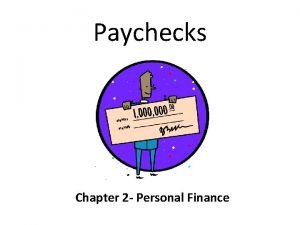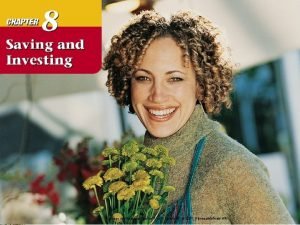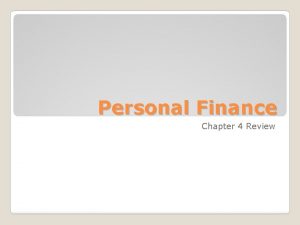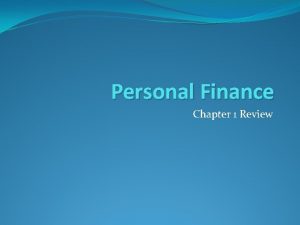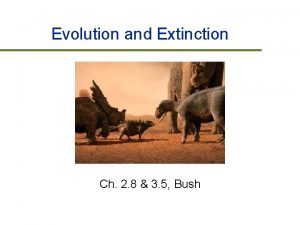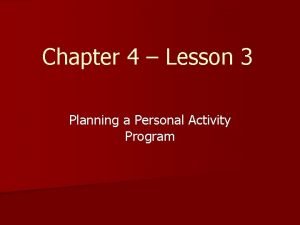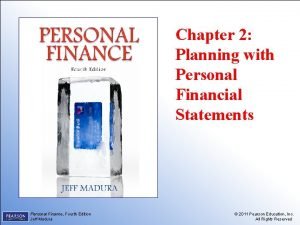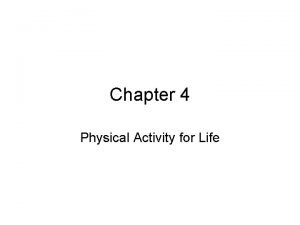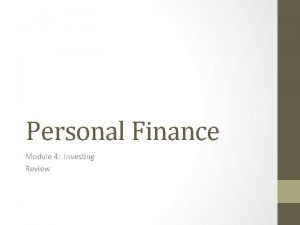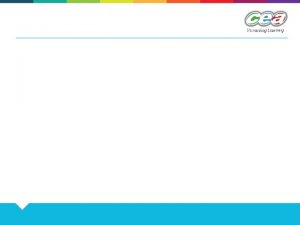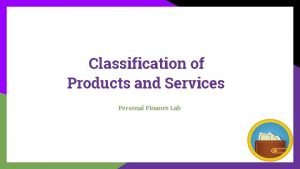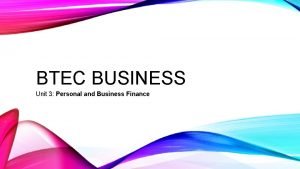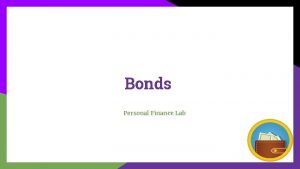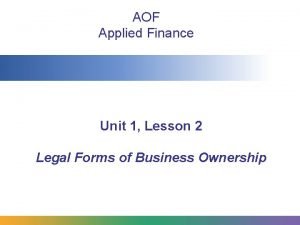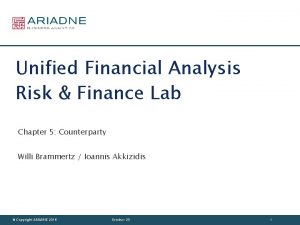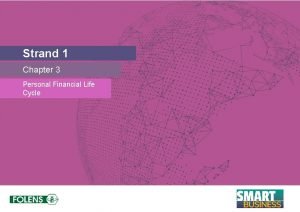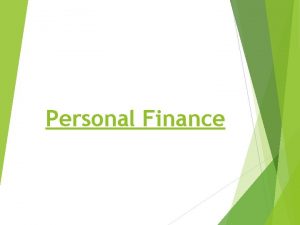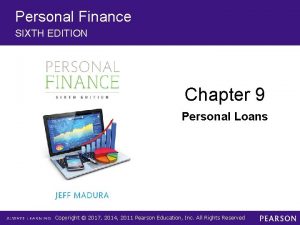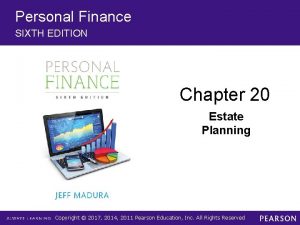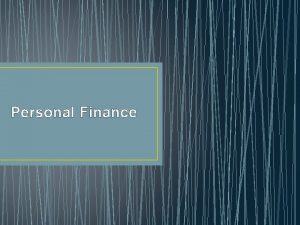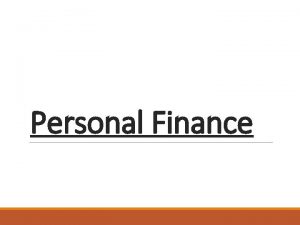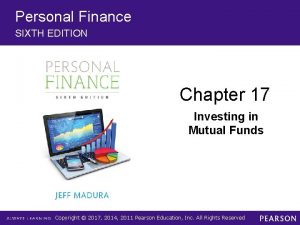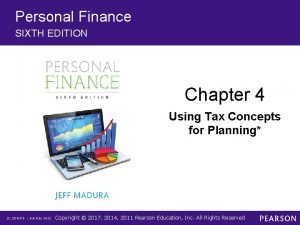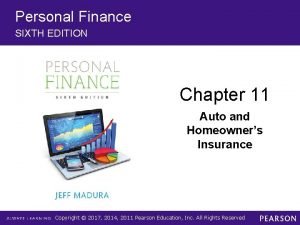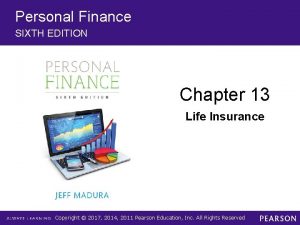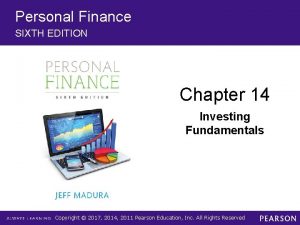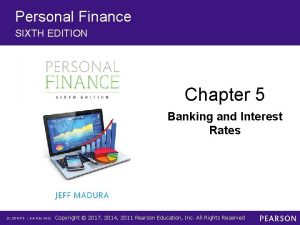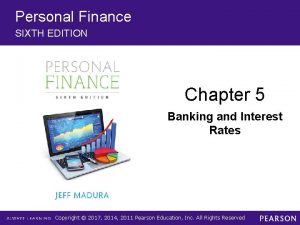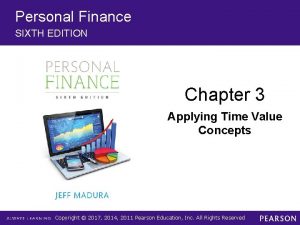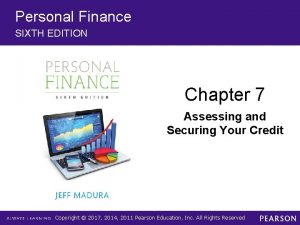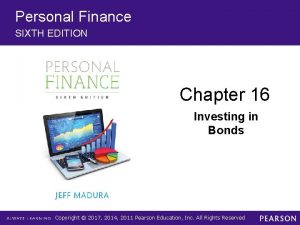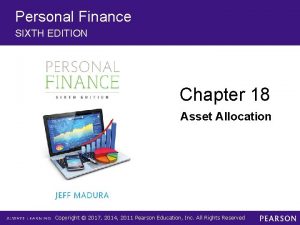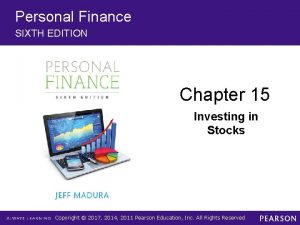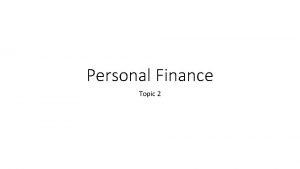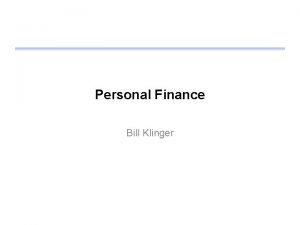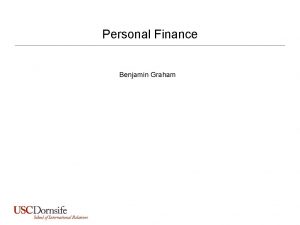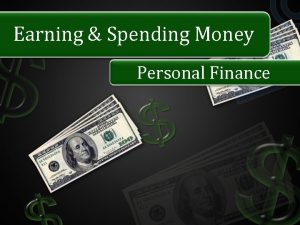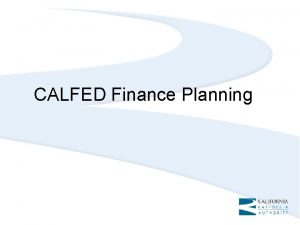Personal Finance SIXTH EDITION Chapter 2 Planning with









































- Slides: 41

Personal Finance SIXTH EDITION Chapter 2 Planning with Personal Financial Statements Copyright © 2017, 2014, 2011 Pearson Education, Inc. All Rights Reserved

Chapter Objectives 2. 1 Explain how to create your personal cash flow statement 2. 2 Identify the factors that affect your cash flows 2. 3 Forecast your cash flows 2. 4 Explain how to create your personal balance sheet 2. 5 Explain how your personal financial statements fit within your financial plan Copyright © 2017, 2014, 2011 Pearson Education, Inc. All Rights Reserved

Personal Cash Flow Statement (1 of 3) • Personal cash flow statement: a financial statement that measures a person’s cash inflows and outflows • Cash inflows include salaries, interest, dividends • Cash outflows include all expenses, both large and small Copyright © 2017, 2014, 2011 Pearson Education, Inc. All Rights Reserved

Personal Cash Flow Statement (2 of 3) • Create a statement by recording your revenues and expenses over a period of time • Net cash flows: cash inflows minus cash outflows Copyright © 2017, 2014, 2011 Pearson Education, Inc. All Rights Reserved

Personal Cash Flow Statement (3 of 3) EXHIBIT 2. 1 Personal Cash Flow Statement for Stephanie Spratt Cash Inflows Disposable (after-tax) income Last Month $2, 500 Interest on deposits 0 Dividend payments 0 Total Cash Inflows Cash Outflows Rent $2, 500 Last Month $600 Internet 50 Electricity and water 60 Cellular 60 Groceries 300 Health care insurance and expenses 130 Clothing 100 Car expenses (insurance, maintenance, and gas) 200 Recreation 600 Total Cash Outflows $2, 100 Net Cash Flows +$400 Copyright © 2017, 2014, 2011 Pearson Education, Inc. All Rights Reserved

Factors That Affect Cash Flows (1 of 3) • Factors affecting cash inflows: – Stage in your career path § Closely related to your stage in the life cycle—college, career, retirement – Type of job § Based on skill level and demand for those skills – Number of income earners in your household Copyright © 2017, 2014, 2011 Pearson Education, Inc. All Rights Reserved

Factors That Affect Cash Flows (2 of 3) • Factors affecting cash outflows: – Size of family – Age – Personal consumption behavior § Some people spend all of their income and more while others spend mainly on necessities and concentrate on saving for the future Copyright © 2017, 2014, 2011 Pearson Education, Inc. All Rights Reserved

Factors That Affect Cash Flows (3 of 3) Copyright © 2017, 2014, 2011 Pearson Education, Inc. All Rights Reserved

Creating a Budget (1 of 8) • Budget: a cash flow statement that is based on forecasted cash flows for a future time period • Budgets are useful for anticipating either cash surpluses or cash deficiencies Copyright © 2017, 2014, 2011 Pearson Education, Inc. All Rights Reserved

Creating a Budget (2 of 8) EXHIBIT 2. 3 Stephanie Spratt’s Revised Personal Cash Flow Statement Cash Inflows Actual Amounts Last Month Expected Amounts This Month $2, 500 Interest on deposits 0 0 Dividend payments 0 0 $2, 500 Actual Amounts Last Month Expected Amounts This Month $600 Internet 50 50 Electricity and water 60 60 Cellular 60 60 Groceries 300 Health care insurance and expenses 130 [430] Clothing 100 Car expenses (insurance, maintenance, and gas) 200 [500] Recreation 600 Total Cash Outflows $2, 100 $2, 700 Net Cash Flows +$400 -$200 Disposable (after-tax) income Total Cash Inflows Cash Outflows Rent Copyright © 2017, 2014, 2011 Pearson Education, Inc. All Rights Reserved

Creating a Budget (3 of 8) EXHIBIT 2. 4 Summary of Stephanie Spratt’s Revised Cash Flows Last Month’s Cash Flow Situation Unusual Cash Flows Expected This Month’s Cash Flow Situation Cash inflows $2, 500 $0 $2, 500 Cash outflows $2, 100 $600 $2, 700 Net cash flows $400 -$600 –$200 Copyright © 2017, 2014, 2011 Pearson Education, Inc. All Rights Reserved

Creating a Budget (4 of 8) • Anticipating cash shortages – Small shortages can usually be made up from your checking account – Budgets provide warning of shortages so that you can prepare for them • Assessing the accuracy of the budget – Compare predicted cash flows to actual cash flows – Adjustment may be necessary Copyright © 2017, 2014, 2011 Pearson Education, Inc. All Rights Reserved

Creating a Budget (5 of 8) • Forecast net cash flows over several months – Use the information for a typical month and adjust it for unusual expenses such as seasonal shopping – Allow for some unexpected expenses like medical care, car and home maintenance • Create an annual budget by extending your budget out for longer periods – Go to the website https: //money. strands. com/ for an App that will help with this task Copyright © 2017, 2014, 2011 Pearson Education, Inc. All Rights Reserved

Creating a Budget (6 of 8) EXHIBIT 2. 5 Stephanie Spratt’s Revised Personal Cash Flow Statement Expected Amounts (forecasted at the beginning of the month) Actual Amounts (determined at the end of the month) Forecasting Error $2, 500 $0 Interest on deposits 0 0 0 Dividend payments 0 0 0 $2, 500 $0 Expected Amounts Actual Amounts Forecasting Error $600 $0 Internet 50 50 0 Electricity and water 60 60 0 Cellular 60 60 0 Groceries 300 280 +20 Health care insurance and expenses 430 0 Clothing 100 170 -70 Car expenses (insurance, maintenance, and gas) 500 0 Recreation 600 650 -50 $2, 700 $2, 800 –$100 -$200 -$300 Cash Inflows Disposable (after-tax) income Total Cash Inflows Cash Outflows Rent Total Cash Outflows Net Cash Flows Copyright © 2017, 2014, 2011 Pearson Education, Inc. All Rights Reserved

Creating a Budget (7 of 8) • Improving the budget – Periodically review the budget to see if you are progressing toward your goals – Look for areas that can be changed to improve the budget over time • Focus on ethics – Don’t become overly dependent on others – Create a budget and stay within it Copyright © 2017, 2014, 2011 Pearson Education, Inc. All Rights Reserved

Creating a Budget (8 of 8) EXHIBIT 2. 6 Annual Budget for Stephanie Spratt Typical Month This Year’s Cash Flows (equal to the typical monthly cash flows × 12) $2, 500 $30, 000 Interest on deposits 0 0 Dividend payments 0 0 Total Cash Inflows $2, 500 $30, 000 Cash Outflows Typical Month Cash Inflows Disposable (after-tax) income Rent This Year’s Cash Flows $600 $7, 200 Internet 50 600 Electricity and water 60 720 Cellular 60 720 Groceries 300 3, 600 Health care insurance and expenses 130 1, 560 Clothing 100 1, 200 Car expenses (insurance, maintenance, and gas) 200 2, 400 Recreation 600 7, 200 Total Cash Outflows $2, 100 $25, 200 Net Cash Flows +$400 $4, 800 (difference between cash inflows and outflows) Copyright © 2017, 2014, 2011 Pearson Education, Inc. All Rights Reserved

Financial Planning Online (1 of 2) • Go to www. moneycrashers. com/five-steps-toeffective-budgeting • This Web site provides tips on effective budgeting based on your goals. • The Web site https: //www. mint. com/ also contains a lot of budgeting information and other financial tools. Copyright © 2017, 2014, 2011 Pearson Education, Inc. All Rights Reserved

Personal Balance Sheet (1 of 15) • Personal balance sheet: a summary of your assets (what you own), your liabilities (what you owe), and your net worth (assets minus liabilities) • A balance sheet reflects your financial position at a specific point in time Copyright © 2017, 2014, 2011 Pearson Education, Inc. All Rights Reserved

Financial Planning Online (2 of 2) • Go to http: //www. dailyfinance. com/ • Search for Calculators • This Web site provides an estimate of the savings you can accumulate over time if you can reduce your spending on one or more of your monthly expenses. Copyright © 2017, 2014, 2011 Pearson Education, Inc. All Rights Reserved

Personal Balance Sheet (2 of 15) • Assets – Liquid assets are financial assets that can be easily sold without a loss in value – Household assets are items normally owned by a household, such as a home, a car, and furniture § You need to establish market values for these assets—the amount you would receive if you sold the asset today Copyright © 2017, 2014, 2011 Pearson Education, Inc. All Rights Reserved

Personal Balance Sheet (3 of 15) – Investment (financial assets) § Bonds: certificates issued by borrower, usually firms and government agencies, to raise funds § Stocks: certificates representing partial ownership in a firm Copyright © 2017, 2014, 2011 Pearson Education, Inc. All Rights Reserved

Personal Balance Sheet (4 of 15) • Mutual funds: investment companies that sell shares and invest the proceeds in investment instruments • Real estate: holdings in rental property and land – Rental property: housing or commercial property that is rented out to others Copyright © 2017, 2014, 2011 Pearson Education, Inc. All Rights Reserved

Personal Balance Sheet (5 of 15) • Liabilities – Current liabilities: debts that will be paid within a year – Long-term liabilities: debts that will be paid over a period longer than one year • Net worth is the difference between what you own and what you owe. Copyright © 2017, 2014, 2011 Pearson Education, Inc. All Rights Reserved

Personal Balance Sheet (6 of 15) • Creating a personal balance sheet – Allows you to determine your net worth – Update it periodically to monitor changes in your net worth over time Copyright © 2017, 2014, 2011 Pearson Education, Inc. All Rights Reserved

Personal Balance Sheet (7 of 15) EXHIBIT 2. 7 Stephanie Spratt’s Personal Balance Sheet Assets Liquid Assets Cash $500 Checking account 3, 500 Savings account Total liquid assets 0 $4, 000 Household Assets Home $0 Car 1, 000 Furniture 1, 000 Total household assets $2, 000 Investment Assets Stocks $3, 000 Total investment assets $3, 000 Total Assets $9, 000 Copyright © 2017, 2014, 2011 Pearson Education, Inc. All Rights Reserved

Personal Balance Sheet (8 of 15) EXHIBIT 2. 7 Stephanie Spratt’s Personal Balance Sheet Liabilities and Net Worth Current Liabilities Credit card balance $2, 000 Total current liabilities $2, 000 Long-Term Liabilities Mortgage $0 Car loan 0 Total long-term liabilities $0 Total Liabilities $2, 000 Net Worth $7, 000 Copyright © 2017, 2014, 2011 Pearson Education, Inc. All Rights Reserved

Personal Balance Sheet (9 of 15) • Changes in the personal balance sheet – Some changes will affect both your personal balance sheet and your net worth – Other changes will affect you personal balance sheet and leave your net worth unchanged • Consider the previous personal balance sheet with the purchase of a new car… • Note that her assets increase but her liabilities increase by the same amount Copyright © 2017, 2014, 2011 Pearson Education, Inc. All Rights Reserved

Personal Balance Sheet (10 of 15) EXHIBIT 2. 8 Stephanie Spratt’s Personal Balance Sheet if She Purchases a New Car Assets Liquid Assets Present Situation Cash $500 Checking account 3, 500 0 0 $4, 000 $1, 000 $0 $0 Car 1, 000 20, 000 Furniture 1, 000 $2, 000 $21, 000 Stocks $3, 000 Total investment assets $3, 000 Total Assets $9, 000 $25, 000 Savings account Total liquid assets If She Purchases a New Car Household Assets Home Total household assets Investment Assets Copyright © 2017, 2014, 2011 Pearson Education, Inc. All Rights Reserved

Personal Balance Sheet (11 of 15) EXHIBIT 2. 8 Stephanie Spratt’s Personal Balance Sheet if She Purchases a New Car Liabilities and Net Worth Current Liabilities Credit card balance $2, 000 Total current liabilities $2, 000 Mortgage $0 $0 Car loan 0 16, 000 $0 $16, 000 Total Liabilities $2, 000 $18, 000 Net Worth $7, 000 Long-Term Liabilities Total long-term liabilities Copyright © 2017, 2014, 2011 Pearson Education, Inc. All Rights Reserved

Personal Balance Sheet (12 of 15) • Impact of the economy on the personal balance sheet – Favorable economic conditions can increase job opportunities and income – Unfavorable economic conditions result in lost jobs and income – Net worth can decline to the point of becoming negative Copyright © 2017, 2014, 2011 Pearson Education, Inc. All Rights Reserved

Relationship Between Cash Flows and Wealth (1 of 2) Copyright © 2017, 2014, 2011 Pearson Education, Inc. All Rights Reserved

How Cash Flows Affect the Personal Balance Sheet • Wealth is built by using net cash flows to invest in assets without increasing liabilities • Net cash flows can be used to decrease liabilities which will increase net worth • Net worth can change even if net cash flows are zero; for example, the value of an asset or investment increases or decreases Copyright © 2017, 2014, 2011 Pearson Education, Inc. All Rights Reserved

Relationship Between Cash Flows and Wealth (2 of 2) Copyright © 2017, 2014, 2011 Pearson Education, Inc. All Rights Reserved

Personal Balance Sheet (13 of 15) • Analysis of the personal balance sheet – Allows monitoring of liquidity, debt, and ability to save – Liquidity is measured by the liquidity ratio § Liquidity ratio = Liquid assets/Current liabilities § From personal balance sheet on previous slides § 4, 000/2, 000 = 2 § Higher liquidity ratio = greater liquidity Copyright © 2017, 2014, 2011 Pearson Education, Inc. All Rights Reserved

Personal Balance Sheet (14 of 15) – Debt level is measured by debt-to-asset ratio § Debt-to-Asset Ratio = Total liabilities/total assets § From personal balance sheet on previous slides § 2, 000/9, 000 = 22. 22% § Higher ratio = higher debt relative to assets Copyright © 2017, 2014, 2011 Pearson Education, Inc. All Rights Reserved

Personal Balance Sheet (15 of 15) – Savings rate measures savings over the period in comparison to disposable income over the period Copyright © 2017, 2014, 2011 Pearson Education, Inc. All Rights Reserved

How Budgeting Fits Within Your Financial Plan (1 of 5) • The key budgeting decisions for building your financial plan are: – How can I improve my net cash flows in the near future? – How can I improve my net cash flows in the distant future? Copyright © 2017, 2014, 2011 Pearson Education, Inc. All Rights Reserved

How Budgeting Fits Within Your Financial Plan (2 of 5) EXHIBIT 2. 11 Application of Budgeting Concepts to Stephanie Spratt’s Financial Plan GOALS FOR A BUDGETING PLAN 1. Determine how I can increase my net cash flows in the near future. 2. Determine how I can increase my net cash flows in the distant future. ANALYSIS Present Situation: Cash Inflows = $2, 500 per month Cash Outflows = $2, 100 per month Net Cash Flows = $400 per month Estimated Savings per Year = $4, 800 ($400 per month× 12 months) Copyright © 2017, 2014, 2011 Pearson Education, Inc. All Rights Reserved

How Budgeting Fits Within Your Financial Plan (3 of 5) EXHIBIT 2. 11 Application of Budgeting Concepts to Stephanie Spratt’s Financial Plan Increase Net Cash Flows by: Increasing my salary? (New job? ) No. I like my job and have no plans to search for another job right now, even if it would pay a higher salary. Increasing my income provided by my investments? No. My investments are small at this point. I cannot rely on them to provide much income. Other? (If yes, explain. ) No. Reduce Cash Outflows by: Reducing my household expenses? No. Reducing my recreation expenses? Yes (by $100 per month). Reducing my other expenses? No. Overall, I identified only one adjustment to my budget, which will increase monthly net cash flows by $100. Copyright © 2017, 2014, 2011 Pearson Education, Inc. All Rights Reserved

How Budgeting Fits Within Your Financial Plan (4 of 5) EXHIBIT 2. 11 Application of Budgeting Concepts to Stephanie Spratt’s Financial Plan DECISIONS Decision to Increase Net Cash Flows in the Near Future: I initially established a budget to save $4, 800 per year. During the next year, I can attempt to save an additional $100 per month by reducing the amount I spend on recreation. I can increase my savings if I reduce cash outflows. By reducing cash outflows by $100 per month, my savings will increase from $400 to $500 per month. The only way that I can reduce cash outflows at this point is to reduce the amount I spend for recreation purposes. Copyright © 2017, 2014, 2011 Pearson Education, Inc. All Rights Reserved

How Budgeting Fits Within Your Financial Plan (5 of 5) EXHIBIT 2. 11 Application of Budgeting Concepts to Stephanie Spratt’s Financial Plan Decision to Increase Net Cash Flows in the Distant Future: My cash inflows will rise over time if my salary increases. If I can keep my cash outflows stable, my net cash flows (and therefore my savings) will increase. When I buy a new car or a home, my monthly cash outflows will increase as a result of the monthly loan payments. If I buy a new car or a home, I need to make sure that I limit my spending (and therefore limit the loan amount) so that I have sufficient cash inflows to cover the monthly loan payments along with my other typical monthly expenses. If I get married someday, my husband would contribute to the cash inflows, which would increase net cash flows. We would be able to save more money and may consider buying a home. If I marry, my goal will be to save even more money per month than I save now, to prepare for the possibility of raising a family in the future. Copyright © 2017, 2014, 2011 Pearson Education, Inc. All Rights Reserved
 Peter pickle tongue twister
Peter pickle tongue twister Rubber baby buggy bumpers tongue twister lyrics
Rubber baby buggy bumpers tongue twister lyrics Personal finance 6th edition
Personal finance 6th edition Biochemistry sixth edition 2007 w.h. freeman and company
Biochemistry sixth edition 2007 w.h. freeman and company Computer architecture a quantitative approach sixth edition
Computer architecture a quantitative approach sixth edition Automotive technology principles diagnosis and service
Automotive technology principles diagnosis and service Automotive technology sixth edition
Automotive technology sixth edition Citation sample pdf
Citation sample pdf Computer architecture a quantitative approach 6th
Computer architecture a quantitative approach 6th Precalculus sixth edition
Precalculus sixth edition Principles of economics sixth edition
Principles of economics sixth edition Computer architecture a quantitative approach sixth edition
Computer architecture a quantitative approach sixth edition Chapter 2 personal finance
Chapter 2 personal finance Introduction to personal finance answers
Introduction to personal finance answers Chapter 8 personal finance
Chapter 8 personal finance Chapter 4 review personal finance
Chapter 4 review personal finance Chapter 1 post test personal finance
Chapter 1 post test personal finance Overview of personal finance chapter 1
Overview of personal finance chapter 1 Sujata madan
Sujata madan Corporate finance tenth edition
Corporate finance tenth edition Fundamentals of corporate finance third canadian edition
Fundamentals of corporate finance third canadian edition Fundamentals of corporate finance fifth edition
Fundamentals of corporate finance fifth edition Corporate finance 6th edition
Corporate finance 6th edition Corporate finance tenth edition
Corporate finance tenth edition Corporate finance tenth edition
Corporate finance tenth edition Corporate finance tenth edition
Corporate finance tenth edition Corporate finance tenth edition
Corporate finance tenth edition Using mis (10th edition) 10th edition
Using mis (10th edition) 10th edition Using mis 10th edition
Using mis 10th edition Modes of speciation ppt
Modes of speciation ppt Chapter 12 lesson 1 benefits of physical activity
Chapter 12 lesson 1 benefits of physical activity Personal activity program
Personal activity program Chapter 2 personal financial planning answers
Chapter 2 personal financial planning answers Chapter 4 physical activity for life
Chapter 4 physical activity for life Module 4: investing test answer key
Module 4: investing test answer key Personal finance gcse
Personal finance gcse Personal finance lab
Personal finance lab Business unit 3 personal and business finance
Business unit 3 personal and business finance Personal finance lab
Personal finance lab Llc advantages and disadvantages
Llc advantages and disadvantages Personal finance lab
Personal finance lab Stages of financial life cycle
Stages of financial life cycle












